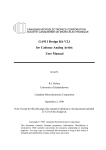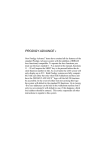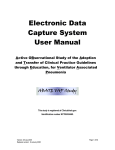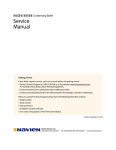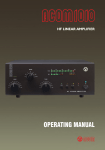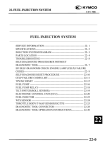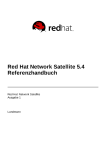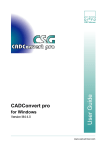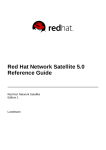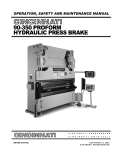Download Using Electric Editor™ with the Gennum GA911 Array
Transcript
Research Centre for Integrated Microsystems University of Windsor Using Electric Editor™ with the Gennum GA911 Array Submitted to Canadian Microelectronics Corporation M.Shahkarami, R. Muscedere, G.A. Jullien Acknowledgements The authors would like to thank Russ Wright and Brian Gardiner at Electric Editor, Dr. Ron Bolton University of Saskatchewan, Canadian Microelectronics Corporation and Gennum Corporation in Burlington, Ontario for their assistance in the development of this design environment. Using Electric Editor™ with the Gennum GA911 Array Research Centre for Integrated Microsystems University of Windsor Contents 1. Features ...............................................................................................................................1 1.1 Nodes .......................................................................................................................1 1.2 Arcs ..........................................................................................................................1 1.3 Connectivity approach .............................................................................................2 1.4 Interaction with third party tools .............................................................................2 2. Operation .............................................................................................................................2 2.5 Elements of producing a design...............................................................................2 2.6 Load a Technology.......................................................................................3 2.7 Load or Create a Library..............................................................................3 2.8 Edit or Create Facets....................................................................................3 2.9 Extract simulation files ................................................................................3 3. A Typical Session ................................................................................................................4 3.10 Electric is initially loaded ........................................................................................4 3.11 The technology has a specific set of primitives .......................................................5 4. The Menu of Primitives .......................................................................................................5 4.12 Pins...........................................................................................................................7 4.13 Metal Interconnect ...................................................................................................7 4.14 Active Devices .........................................................................................................8 4.15 Passive Devices ........................................................................................................9 5. Load design library GennumFlat .......................................................................................10 5.16 GA911 Array Symmetry........................................................................................14 6. A Single Transistor Circuit ................................................................................................15 6.17 Metal Interconnect Guidelines...............................................................................15 6.18 Making Connections ..............................................................................................16 6.19 Connecting the single transistor circuit .................................................................20 7. Additional Information ......................................................................................................38 7.20 The GA911 Technology [3] ...................................................................................38 7.21 GA911 Array Components ....................................................................................39 7.22 GA911 Array Device Layouts ...............................................................................40 7.23 Resistor Lands........................................................................................................41 7.24 Notes on Performing Layout of Metal Interconnect ..................................42 7.25 Substrate Contacts......................................................................................43 7.26 Bond Pad Structures and ESD Protection Strategies .............................................44 7.27 The LF Bond Pad Structure .......................................................................44 8. Device Details ....................................................................................................................45 iii Research Centre for Integrated Microsystems 8.28 8.29 8.31 8.32 8.33 8.34 9. University of Windsor .Small NPN Transistor (SNPN) .............................................................................45 Large NPN Transistor (LNPN) ..............................................................................46 Large Emitter NPN Transistor or Junction Capacitor (CAP_NPN) ......................47 Substrate (vertical) PNP Transistor (SUB_PNP)..................................................49 P-channel JFET 90K Pinch Resistor (PNCHR90K)..............................................50 Diffused Resistors ..................................................................................................51 References..........................................................................................................................52 iv Research Centre for Integrated Microsystems University of Windsor Using Electric EditorTM with the Gennum GA911 Array 1. Features This package provides all of the tools associated with modern VLSI design software, but its strong feature is the inclusion of connectivity information within mask layout designs. In this way mask layouts are directly mappable to circuits since all of the polygons placed on the screen make sense in terms of the normal elements of a circuit: nodes and arcs. 1.1 Nodes A set of primitives are available to represent all of the possible nodes within a particular technology. Each of the primitives carry complete layer information associated with that node. In the Gennum technology [2] the user is only concerned with placing a single layer of metal to connect existing primitives “locked” into the GA911 array. The metal is placed using metal nodes or pins and then making a connection between them. There is an on-line Design Rule Checker that informs the design if the metal nodes or pins are too close to other metal lines or to the fixed primitives. The connectivity information to the primitives is contained in pins that exist at the ends of all connectable layers forming the primitive. Ports are attached to these pins when connectivity information is to be passed up the hierarchy that is part of the VLSI design process. 1.2 Arcs Nodes are connected by arcs. In the GA911 array, the only connection medium is a single layer of metal (aluminum). The GA911 technology in Electric, however, provides 3 different types of arcs which all map to the same metal layer when the array is fabricated [1]. These layers are: metal (used for signal connections); metal-Vcc (used for positive power supply connections); metal-Vee (used for negative power supply connections). Using different layers (which have different colors) helps to “read” the circuit from the layout. Features 1 Research Centre for Integrated Microsystems University of Windsor 1.3 Connectivity approach Rather than a pure polygon generator, Electric requires connections to be made between nodes and arcs. The connections are made by identifying two pins of the same type of layer and executing the connection command. It is important to note that connections to the same type of layer cannot be made by simply making the layers adjacent (this is often the case with other VLSI packages) but a connection has to be made, otherwise the design rule checker will generate an error. This connectivity information can be used to directly extract schematics. The schematics use nodes and arcs in the same orientation as the mask layout. 1.4 Interaction with third party tools Electric is an open system and many tools have been added. For this course we will be using a third party SPICE program (PSPICE) in conjunction with the schematic generator in Electric. We will be able to simulate circuits directly from the connections made to the GA911 array. 2. Operation Electric runs on most workstations. These notes briefly describe the use of Electric on a PC computer system, with special emphasis on the Gennum Corp. GA911 array. 2.5 Elements of producing a design All designs are created using the following four major steps. The actual design process may take hundreds of hours if it is a very complicated full custom design in a modern CMOS technology, or just a few hours for a simple design in a more straightforward technology, such as the GA911 analog array. Operation 2 Research Centre for Integrated Microsystems University of Windsor 2.6 Load a Technology The technology contains the primitives and design rules of the particular technology of fabrication. Many different technologies are available within the Electric libraries, and there is also the capability of editing new technology files, though this is beyond the level required in this course. 2.7 Load or Create a Library A design is created within a library. Several libraries can be resident within Electric at any one time. The library contains a set of facets (different mask layouts of parts of the design) with the facets usually forming a hierarchy, so that facets at the upper levels of the hierarchy use instances of facets at the lower levels. Facets can be imported from other libraries resident within Electric. New libraries can be loaded when required. Because of the many protocol translators within the package, it is possible to import libraries in different protocols. It is important to note that these external protocols may not provide Electric with connectivity information, and therefore will cause design rule errors to be generated for each violation associated with lack of connectivity information. For the GA911 array [2], we will be restricting ourselves to making connections on a single facet called “2x1-layout”. 2.8 Edit or Create Facets From an existing library of facets, new facets are created. The new facet consists of node primitives, instances of existing facets (with ports for connectivity) connected by arc primitives. This new facet can be passed up the hierarchy by defining ports at appropriate pins and exporting the ports to allow connections when the facet is instantiated. For the GA911 array, the only facet instantiation will be for a SPICE simulation where the instantiated facet is connected to SPICE sources and meters. 2.9 Extract simulation files Once a design is complete (or parts of it complete) netlist files may be extracted for use in third party simulators. For the GA911 array, a PSPICE file can be created that is an extraction from the Operation 3 Research Centre for Integrated Microsystems University of Windsor geometry of the design using appropriate parameters from the technology files for the various devices (nodes) in the circuit. Electric allows the connection of sources and meters directly to the mask layout in order to define the simulation required. This is possible because of the connectivity information stored within the layout (the set of polygons on the screen are represented as a circuit within the Electric database). 3. A Typical Session The following subsections show a typical design session with screen dumps from the PC package [5]. It is expected that these notes will be used along with actual practice on the CAD package running on a colour monitor. 3.10 Electric is initially loaded In the PC, Electric is loaded (launched) from the “Start” menu. When loaded, an “About” window appears. Simply click on Continue to continue with the program. The window shown in Figure 1 will appear. The default “gennum” technology is loaded (bipolar process GA911 array from Gennum Corp.), and an initial library (“noname”) created. There are no facets in the library, and the screen indicates that it is not editing a facet. A Typical Session 4 Research Centre for Integrated Microsystems University of Windsor Figure 1. Startup Window. 3.11 The technology has a specific set of primitives When the technology loads, the node and arc primitives associated with the technology are shown in a palette to the left of the working area in the window; see Figure 1. 4. The Menu of Primitives The primitives are either nodes or arcs. The arcs reflect the different conducting layers available in the technology. The nodes represent devices (transistors and resistors), interlayer connectors and pins. Pins will also be present within arc and node primitives. When nodes are selected, the cursor changes to a hand to indicate that the node can be placed. For arcs, the arc is only generated when a pin is selected with the left mouse button, the cursor placed at the other end of the arc placeThe Menu of Primitives 5 Research Centre for Integrated Microsystems University of Windsor ment, and the right mouse button clicked. For the GA911 array, the only nodes that we will place are the metal nodes; transistor and resistor array primitives are not to be placed since they are already fixed in place in the “2x1-layout” facet. The menu reflects this since all of the nodes and arcs that can be placed are on the left hand side of the menu, primitives on the right hand side are all fixed in place primitives. We will now briefly review the primitives associated with the Gennum technology (Figure 2). NODE: Glass-mask-Node NODE: small-PNP-transistor NODE: Metal-Node NODE: sub-PNP-transistor NODE: DRC-Error-Node NODE: large-NPN-transistor NODE: Metal-Vee-Node NODE: small-NPN-transistor NODE: Metal-Vcc-Node NODE: 10k-bent-resistor NODE: Fixpin NODE: 1k-5k-bent-resistor NODE: Metal-Vee-Pin NODE: land-xu NODE: Metal-Vcc-Pin NODE: 200-ohm-long-resistor NODE: Metal-Pin NODE: land NODE: 1k-short-resistor ARC: Fixarc NODE: 90k-pinch-resistor ARC: Metal-Vee ARC: Metal-Vcc NODE: 10k-long-resistor ARC: Metal NODE: 5k-long-resistor Figure 2. Menu palette for the GA911 Array The Menu of Primitives 6 Research Centre for Integrated Microsystems University of Windsor 4.12 Pins Pins are used to anchor the ends of arcs in automatic connection modes. They are also found in node and arc primitives. They can be placed separately before an arc is drawn and used to define the starting point for the arc. They are also used to define connection ports for allowing connections to instantiations of the facet in other facets. The pins are placed in Figure 3, and the three different colours (red, green and blue) of the pins corresponds to the colours of the metal traces.In this technology blue represents metal; red represents metal-Vcc; green represents metal-Vee. As mentioned in Section 1.2, these three different connection media all map to a single layer of metal in the final fabricated chip. Figure 3. Primitives of Pins 4.13 Metal Interconnect Circuit interconnect is performed using a single layer of metal. The minimum metal track width is 6µm and the minimum space between metal features is 4µm, except for metal to bond pad spacing which is 14µm. Figure 4 illustrates a placing of these nodes. Note that when a node is selected a “+” appears in the center of the node. The Menu of Primitives 7 Research Centre for Integrated Microsystems University of Windsor Figure 4. Nodes connecting to Metal 4.14 Active Devices The Gennum technology contains five active device types. There are two NPN transistor types, one large with dual emitters and one small; one PNP transistor type, with dual collectors; one 90kW pinch resistor type; and one three terminal multi-purpose device type that can be used as an NPN transistor, a substrate PNP transistor or a junction capacitor. The NPN and PNP transistors are three terminal devices, with the terminal labelled: B for base; C for collector; E for emitter. Figure 5 shows the different active devices present in this technology. Figure 5. Primitives of Active devices The Menu of Primitives 8 Research Centre for Integrated Microsystems University of Windsor You will notice that these devices have multiple terminals with the same name. For example the small NPN has four collector terminals, as shown in Figure 6 [3]; the collector terminals are internally connected. For more info see “Device Details” on page 45. Figure 6. SNPN schematic and physical layout 4.15 Passive Devices There are four discrete resistors available: 200Ω, 1kΩ, 5kΩ,and 10kΩ. The device outlines resistor lands and land contacts are outlined in Figure 7. Figure 7. Primitives of passive devices The Menu of Primitives 9 Research Centre for Integrated Microsystems University of Windsor Diodes can be implemented by connecting to one end of a resistor and an associated resistor land contact. The 90KΩ resistor is formed by pinching off a channel with a reverse-biased pn junction, so it is somewhat more restricted in its use than the other four resistors. For more detail see “Device Details” on page 45. 5. Load design library GennumFlat We will begin by loading the design library, as shown in Figure 8; Open Library is selected from the File menu and a window appears that asks for the name of the library; Figure 9 shows this process. The next step is to save this library as your working library, giving it an appropriate name. Select SaveAs from the File menu. Type the path to where you wish to save the library in the window that appears. Figure 8. Opening the design Library Load design library GennumFlat 10 Research Centre for Integrated Microsystems University of Windsor Figure 9. Opening the GennumFlat Library The screen can be regarded as a template for your design. What will appear on the screen is the layout of an array named 2x1-layout, which consists of transistors, resistors and capacitors that are unconnected. (Figure 10). If yours is different from Figure 10, then perhaps the wrong facet is opened. Under the Facet menu, click on Edit New Facet. Then choose 2x1-layout from the list of facets and click OK. This process is shown in Figure 11. Load design library GennumFlat 11 Research Centre for Integrated Microsystems University of Windsor Figure 10. Layout of the 2x1 array Load design library GennumFlat 12 Research Centre for Integrated Microsystems University of Windsor Figure 11. Edit New Facet Load design library GennumFlat 13 Research Centre for Integrated Microsystems University of Windsor 5.16 GA911 Array Symmetry The contents of the 2x1 array can be seen in Figure 12 and Figure 13 [3]. The tiles form several lines of symmetry. This symmetry of the Block (Quad) and Street (half) Tiles allows metal interconnect routes to be easily replicated using mirroring and rotation operations. Figure 12. 2x1 Array Figure 13. 2x1 Array Symmetry Load design library GennumFlat 14 Research Centre for Integrated Microsystems University of Windsor 6. A Single Transistor Circuit We will illustrate the design process by constructing a single transistor circuit that will be used as in the first laboratory of the course. The schematic of the circuitry that will be wired on the array is shown in Figure 14. Vcc RC 10KΩ RB 5KΩ + Vout Q1 SNPN + 10v - Vin - Vee Figure 14. Single transistor circuit The inverter is constructed by connecting an NPN transistor and resistors using arc primitives. In order to do so we must first learn how to make connections. 6.17 Metal Interconnect Guidelines As mentioned before, circuit interconnect is performed using a single metal layer, and before we start there are a few points to make. 1. The most acceptable geometry is called Manhattan, where lines can only be at 90° angles to each other. Acute angles can not be used. 2. Analog circuits often use symmetry (for example differential amplifiers), and it is useful to use the inherent symmetry in the “mirrored” tiles to build each side of a symmetric circuit (by mirroring the connections). One component that might cause a problem if it is part of a mirrored circuit is the pinch resistor. This device works by using a pn junction to “pinch-off” the conductive channel, and so the connections to it always have to be of the same polarity. Check the operation of the circuit, in terms of polarity, carefully before making the connections to this device. A Single Transistor Circuit 15 Research Centre for Integrated Microsystems University of Windsor 3. The pinch resistor can only tolerate a maximum of 6v between its terminals before it breaks down, so again check the operation of the circuit carefully before using this resistor. 4. The isolation technique used in the GA911 array is by isolating components in reverse biased pn junctions. In order to maintain the reverse bias it is important to connect the substrate to the most negative chip supply voltage (see “Substrate Contacts” on page 43 for more details) and the resistor land contacts to the most positive chip supply voltage or at least to a circuit node that is always more positive than the potential applied to any resistor contained in that land (see “Resistor Lands” on page 41 for more information). 6.18 Making Connections To make a connection, we first select one of the metal arcs (depending on its use) from the primitive menu. You will notice that the arc name shows up at the bottom of your library menu. An example of making a connection between two NPN transistor is shown in Figure 15-17. Figure 15. Click on left mouse button to highlight start of connection A Single Transistor Circuit 16 Research Centre for Integrated Microsystems University of Windsor Remember that there are three different metal arcs, metal-Vee (green), metal-Vcc (red) and metal (blue). Use the first two only when connecting to the most negative or most positive nets of your circuit, respectively; use metal for all other interconnections. As shown in Figure 15, in order to make a connection between the two transistor nodes, first select Arc: metal from the primitive menu, then click the left mouse button on the lower right hand collector of the left transistor. Next, place the cursor where the next point of routing should be and click the right mouse button (Figure 16). Finally place the cursor on the upper left collector of the transistor on the right, and click the right mouse button to complete the connection (Figure 17). Figure 16. Click right mouse button on second point of connection A Single Transistor Circuit 17 Research Centre for Integrated Microsystems University of Windsor Figure 17. Click right mouse button on final destination of metal interconnect Here are some more example of connections. Figure 18. Examples of connections to transistors A Single Transistor Circuit 18 Research Centre for Integrated Microsystems University of Windsor Figure 19. Example of connection to pads Figure 20. Example of connection to resistors and resistor land A Single Transistor Circuit 19 Research Centre for Integrated Microsystems University of Windsor 6.19 Connecting the single transistor circuit The circuit to be connected is shown in Figure 14 and the final layout is shown in Figure 21. The schematic can be obtained directly from this “mask layout”. To start constructing the circuit, we locate the various components (small NPN, 10kΩ and 5kΩ resistors) on the “2x1-layout”. Next we make connections using Arc: metal to connect the base of the transistor to one side of the 5kΩ resistor, connect the collector of the transistor to a 10kΩ resistor, connect the other side of the 5kΩ resistor to a bonding pad (used to apply the input signal). We then use Arc: metal-Vcc to connect the other side of the 10kΩ resistor to another bonding pad (used to apply the positive side of the power supply). Finally use Arc: metal-Vee to connect the emitter of the transistor to another bonding pad (used to apply the negative side of the power supply - in this case this will also be ground). Figure 21. The connected array (layout) The next step is to add ports to the design so that the layout can be “instantiated” to another facet and connections made to allow SPICE simulations to be conducted. Ports are created from the Port menu by selecting Create Port. This process is shown in Figure 22 A Single Transistor Circuit 20 Research Centre for Integrated Microsystems University of Windsor Figure 22. Adding ports A Single Transistor Circuit 21 Research Centre for Integrated Microsystems University of Windsor In Figure 23, the power, ground, input and output ports are exported to be used for interconnection at the next level of hierarchy. This is done from the Port menu, selecting Re-Export Everything. Figure 23. Exporting Ports In Figure 24 a schematic facet is created from the mask layout, by selecting Make Schematic from the View menu. Note the exact matching of geometry between the mask layout and the schematic. It is important to note that for normal design techniques, where nodes and arcs on a mask layout have been oriented to provide as short connections as possible, we will not obtain standard geometries for normal schematic representation. The resulting schematic is shown in Figure 25. We will now use the modified 2x1-layout array facet to create a facet, Test.(lay), at a higher level of hierarchy. We start by creating the new facet, as shown in Figure 26, by selecting Edit New facet from the Facet menu. A Single Transistor Circuit 22 Research Centre for Integrated Microsystems University of Windsor Figure 24. Making a Schematic view from layout Figure 25. Resulting schematic from layout of 2x1 array A Single Transistor Circuit 23 Research Centre for Integrated Microsystems University of Windsor Figure 26. Edit new Facet Test A Single Transistor Circuit 24 Research Centre for Integrated Microsystems University of Windsor An instance of the modified 2x1-layout facet can now be placed in the Test facet, by selecting New Facet Instance from the Edit menu, see Figure 27. We note that the array does not appear with all its masks, as originally laid out, but is simply a rectangle sized to exactly cover the largest mask polygons in the original layout. We can check this out by peeking inside the instance, as in Figure 28. This is done from the Facets menu by selecting Look Inside Highlighted. We can also modify the instance so that it always displays the internal contents (though it will not be possible to select any of the internal contents except exported ports). In order to be able to register the ports for the SPICE simulation that will follow, we now re-export the ports. Highlight the entire array (unexpanded) and then use the re-export command, as shown in Figure 23. We now set up for generating a SPICE simulation file by connecting a power supply, substrate (ground) and meters to the mask layout using New SPICE Parts under the Edit menu and selecting one of the options. Now place the Spice part in the Facet window. A window will open prompting for a Spice card declaration. We set the SPICE declaration for the 10v power supply to dc 10v. The supply is placed and connected using generic connection wire, since there is no concept of different conducting media at the schematic level. This is shown in Figure 29. The type of analysis is chosen from the New SPICE Parts menu as well. It is important to note that for a dc or ac analysis, the Spice part must be connected to the node being swept (similar to a voltage supply). For transient analysis the Spice part can be place anywhere on the schematic (not connected to anything). A Single Transistor Circuit 25 Research Centre for Integrated Microsystems University of Windsor A Single Transistor Circuit 26 Research Centre for Integrated Microsystems University of Windsor Figure 27. Placing an instance of modified 2x1-layout in Test A Single Transistor Circuit 27 Research Centre for Integrated Microsystems University of Windsor Figure 28. Peeking Inside 2x1-layout instance A Single Transistor Circuit 28 Research Centre for Integrated Microsystems University of Windsor Figure 29. Adding sources (New SPICE Part) A Single Transistor Circuit 29 Research Centre for Integrated Microsystems University of Windsor Figure 30 shows the full mask with all meters and a transient declaration placed (the transient declaration is used to control the printing resolution and simulation time for the SPICE run). Figure 30. Test(layout) with sources connected The next step is to create a schematic facet from “Test” layout facet. Go to View menu and select Make Schematic. This process is shown in Figure 31 The resulting schematic facet is shown in Figure 32. A Single Transistor Circuit 30 Research Centre for Integrated Microsystems University of Windsor Figure 31. Making a schematic view from Test(layout) A Single Transistor Circuit 31 Research Centre for Integrated Microsystems University of Windsor Figure 32. Resulting Test(sch) We can now write the SPICE file; this done from the Tools menu. Click on Simulation Interface then Write SPICE Deck. This process is shown in Figure 33. Any errors will be displayed on the message board, and a window will open for saving the resulting netlist. A Single Transistor Circuit 32 Research Centre for Integrated Microsystems University of Windsor Figure 33. Writing SPICE Deck The complete SPICE listing is saved as shown in Figure 34 and the simulator PSpiceAD is launched to run the netlist. A Single Transistor Circuit 33 Research Centre for Integrated Microsystems University of Windsor Figure 34. Saving the SPICE Netlist After a successful simulation your window should look like Figure 35. The output file generated will be viewed with a graphing package (see Figure 36) A Single Transistor Circuit 34 Research Centre for Integrated Microsystems University of Windsor Figure 35. Successful Simulation The following figure shows how to start the graphing package MicroSim Probe and how to add the waveforms for viewing. From the PSpiceAD window select File then RunProbe (Figure 36). This will launch the graphing package and a display window will open (the background will be black). To add waveforms to be displayed, select Trace and then Add from the MicroSim Probe window (Figure 37). An “Add Trace” window will open that will list the waveform available for graphing. Make your selection and click OK (Figure 38).The window will now show a graph of your selected waveform (Figure 39). A Single Transistor Circuit 35 Research Centre for Integrated Microsystems University of Windsor Figure 36. Run Probe A Single Transistor Circuit 36 Research Centre for Integrated Microsystems University of Windsor Figure 37. Adding waveforms Figure 38. Selecting the waveforms A Single Transistor Circuit 37 Research Centre for Integrated Microsystems University of Windsor Figure 39. Output waveforms (reverse video) 7. Additional Information 7.20 The GA911 Technology [3] Gennum's GA911 technology is a tile-based linear bipolar transistor array that allows designers to create prototype IC layouts by simply connecting the array devices using a single layer of metal interconnect. The layer of interconnect is used in fabrication as the programming layer for the devices. The arrays contain a selection of standard devices in fixed positions, usually mirrored and/or rotated copies of other similar cells. This allows the use of mirroring and rotation to achieve layout symmetry. The designer routes the interconnect metal between individual device pins to lay out the circuit. During this process the full hierarchy of the base arrays can be visually inspected for design rule errors and electrical rule errors. Additional Information 38 Research Centre for Integrated Microsystems University of Windsor The devices in the array consist of resistors (5 sizes), NPN transistors (2 sizes, 3 configurations), PNP transistors (1 size, 2 configurations), Multi-purpose devices (3 sizes, 3 configurations), and bond pads (2 configurations). Typical overall performance parameters for the technology are ft=300 MHz, Vmax=20 volts. 7.21 GA911 Array Components The three tables below (Tables 1-3) list the devices which are available. For the purposes of calculation, two sub-tile groupings can be used; these are the Block Tile (consisting of four BlockQuadrant tiles), and the Street Tile (consisting of two Half-Street tiles). Table 1. Block Tile (4 Block-Quadrant Tiles) Contents Count 28 12 28 8 4 4 8 Device Small NPN Small split-collector lateral PNP P- diffused resistor (Values: 1KΩ, 5KΩ, and 10KΩ. Total:88KΩ) P+ diffused resistors (Value: 200Ω) Pinch resistor (Value: 90KΩ) NPN/substrate PNP/junction capacitor/low frequency bond pad P- resistor cluster/high frequency bond pad Table 2. Street Tile (2 Half-Street Tiles) Contents Count 8 4 2 2 Device Small NPN Small split-collector lateral PNP Large vertical NPN Pinch resistor (Value: 90KΩ) Additional Information 39 Research Centre for Integrated Microsystems University of Windsor Table 3. 2x1 Array Contents Count 64 28 2 56 16 10 8 16 Device Small NPN Small split-collector lateral PNP Large NPN P- diffused resistor (Values: 1KΩ, 5KΩ, and 10KΩ. Total: 176KΩ) P+ diffused resistor (Value: 200Ω) Pinch resistors (Value: 90KΩ) NPN/substrate PNP/junction capacitor/low frequency bond pad P- resistor cluster/high frequency bond pad 7.22 GA911 Array Device Layouts Figure 40 shows the layout outlines of each of the active device geometries. Note that the Small PNP Transistor is a dual collector device while the Large NPN Transistor is a dual emitter device. The 90KΩ Pinch Resistor is made using a P-type JFET device. The Multi-purpose device can be configured as an NPN transistor, a substrate PNP transistor, or a junction capacitor. Additional Information 40 Research Centre for Integrated Microsystems University of Windsor Figure 40a: Small NPN Transistor Figure 40c: Small PNP Transistor Figure 40b: Large NPN Transistor Figure 40d: 90kΩ Pinch Resistor Figure 40e: Multi-purpose Device Figure 40. Active Device Layouts 7.23 Resistor Lands Figure 41 shows the land areas containing the P-diffused resistors. Note that all four Block-Quadrant tiles share the common resistor land at the center of the block tile. There are four discrete resistor values available: 200Ω, 1KΩ, 5KΩ, and 10KΩ. Each land area containing used resistors should always be connected to the most positive chip supply voltage (Vcc) or at least be con- Additional Information 41 Research Centre for Integrated Microsystems University of Windsor nected to circuit node which is more positive than the potential applied to any of the resistors contained in that land. Connections to a resistor land area can be made through the use of the land contacts. In the case of multiple contacts, it is only necessary to connect one of the contacts to the land bias voltage. Unused resistor lands need not be biased Land contact Land contact Land contact Land contact Land contacts Figure 41. Resistor Lands and Land Contacts 7.24 Notes on Performing Layout of Metal Interconnect 1. Non-Manhattan geometries are not recommended. Acute angles should be avoided, as should traces or polygons which overlap back onto themselves. 2. Be careful to note the orientation of the 90KΩ pinch resistor in the Street Tiles when performing mirroring operations. 3. Be aware of the 6V breakdown of the 90KΩ pinch resistor when using this device. 4. The substrate should always be connected to the most negative chip supply voltage. In the GA911 technology this is Vee. 5. Resistor land areas containing used resistors should always be connected to the most positive chip supply voltage (Vcc) or at least to a circuit node which is always more positive than the potential applied to any of the resistors. It is recommended that they be connected to Vcc. Additional Information 42 Research Centre for Integrated Microsystems University of Windsor 7.25 Substrate Contacts The 2x1 array and other multi-tile arrays have substrate contacts running between Block Tile and Street Tile formations (see Figure 42). In some situations where it may be convenient to use these as a connection to the negative chip supply, some caution should be exercised. The resistance from a substrate contact to the outer pickup ring is typically 70Ω or more. Any positive current flowing into a substrate contact will raise the potential of the substrate in the vicinity of the entering current, and this may couple any fluctuations in the current to adjacent circuit blocks and cause crosstalk or instability. In the case where the impressed voltage is greater than a few hundred millivolts, it will cause forward biasing of the epi-substrate junction which in turn will cause injection of the electrons into the substrate, usually resulting in a critical circuit malfunction. Similar caution should be employed in the use of the substrate PNP device (where the collector current flows directly into the substrate), or an NPN device driven hard into saturation (in which case a portion of the base current flows into the substrate). In these cases it is recommended that the substrate contacts adjacent to the device should be connected directly to the outer substrate pickup ring whenever possible. Alternatively, try to use a device which is adjacent to the pickup ring. Outer Substrate Pickup Ring Substrate Contacts Substrate Contacts Additional Information 43 Research Centre for Integrated Microsystems University of Windsor Figure 42. Substrate Contacts 7.26 Bond Pad Structures and ESD Protection Strategies GA911 bond pad structures are designed to be multi-purpose to avoid wasted space. There are two types of bond pad structures, termed HF (for high frequency) and LF (low frequency) based on the amount of parasitic capacitance associated with the pad. 7.26.1 The HF Bond Pad Structure The HF bond pad structure can either be used as a resistor cluster or as a bond pad when it occurs at the Edge of the array. It is not recommended to use the resistors which lie beneath a used bond pad (i.e., all used HF bond pads on the Edge of the array) as they may be damaged during the pad bonding process. In either case the land contact may be used as a cross-under. A recommended use for this cross-under is to feed the positive supply (Vcc) rail into the BlockQuadrant since this provides bias for the resistor land at the same time. The bond pad metal is electrically isolated from the underlying silicon by a layer of oxide. The resulting capacitance at the interface is approximately 0.35pF. HF bond pad structures which are not at the Edge of the array have the pad metal removed to allow for more routing space. 7.27 The LF Bond Pad Structure The LF bond pad structure can either be used as a multi-purpose device (a large NPN transistor, a substrate PNP transistor, or a junction capacitor) or as a bond pad when it occurs at the edge of the array. LF bond pad structures which are not at the edge of the array retain their metal cover since it is a device contact. They cannot be bonded out. The parasitic capacitance of this pad is about 5 times higher (~1.75pF) than that of the HF bond pad due to the connections to the underlying diffusions. Additional Information 44 Research Centre for Integrated Microsystems University of Windsor 8. Device Details 8.28 .Small NPN Transistor (SNPN) symbol layout BlockName: SNPN ModelName: SNPN_911 PSPICE Netlist Format: Q[name] [C] [B] [E] [#Vee] SNPN_911 Notes: 1. This device actually appears as SNPN in the layout. 2. The Small NPN device model includes the collector to substrate capacitance CJS and the collector to substrate diode saturation current ISS. For this reason the substrate node must be specified. 3. If the PSPICE simulator is used and a name (not a number) is used for the substrate node, it must be enclosed in square brackets. Otherwise it will be interpreted as the model name. Parasitic models: The diozen parasitic diode model can be added across the emitter-base of all NPN devices for modeling the reverse emitter-base breakdown. These models will be added if you request diode models during the parasitic extraction phase. The reverse emitter-base breakdown voltage is approximately 6V. Qzen N P N VEE snpn_911 Dzen P N diozen Device Details 45 Research Centre for Integrated Microsystems University of Windsor The saturation current of the diode is purposely made very low so that there is negligible effect on the transistor in the normal forward operating region. The anode of the diode is connected to the base of the transistor and the cathode is connected to the emitter. 8.29 Large NPN Transistor (LNPN) symbols layout BlockNames: LNPN (single emitter), S2LNPN (dual emitter) ModelName: LNPN_911 PSPICE Netlist Format: Q[name] [C] [B] [E] [#Vee] LNPN_911 (x2 if both emitters) Notes: 1. The Large NPN device model includes the collector to substrate capacitance CJS and the collector to substrate diode saturation current ISS. For this reason the substrate node must be specified. 2. If the simulator PSPICE is used and a name (not a number) is used for the substrate node, it must be enclosed in square brackets. Otherwise it will be interpreted as the model name. Parasitic Models: As for the small NPN device, the diozen model may be used to model reverse emitter-base breakdown. However the diode model requires an area scaling factor of 5.5 as shown in the example below. Qzen N P N VEE lnpn_911 Dzen P N diozen 5.5 Device Details 46 Research Centre for Integrated Microsystems University of Windsor 8.30 Small Split-Collector Lateral PNP Transistor (SPNP) symbols layout BlockName: SPNP (single collector), S2PNP (split collector) ModelName: SPNP_911 PSPICE Netlist Format: Q[name] [C] [B] [E] [#Vee] SPNP_911 0.5 (x2 if both collectors) Notes: 1. An unused collector MUST be tied either to a used collector or Vee. Otherwise the open collector will cause the transistor to saturate. 2. The model includes base-substrate diode capacitance, therefore the substrate terminal must be given. 3. In PSPICE this device should be modeled with the LPNP model type (see Appendix 3). Parasitic Models: None. 8.31 Large Emitter NPN Transistor or Junction Capacitor (CAP_NPN) This device can be created from the multipurpose device shown below. It can be used as either a very large emitter NPN transistor or a junction capacitor. The performance of this device, when used as a NPN transistor, limits its use to medium speed, medium to high current output buffers. As with the NPN transistor models, the substrate node is required. Device Details 47 Research Centre for Integrated Microsystems University of Windsor symbol layout BlockName: CAP_NPN ModelName: CAP_NPN PSPICE Netlist Format: Q[name] [C] [B] [E] [#Vee] CAP_NPN Notes: 1. Device configured as a 3pF capacitor (at zero reverse bias). Positive end of capacitor has approximately 3.3pF parasitic capacitance to the substrate. It has a 5V reverse breakdown voltage. Qcap3p C+ C- C- Vee CAP_NPN 2. Device configured as a 9pF capacitor (at zero reverse bias). Negative end of capacitor has approximately 3.3pF parasitic capacitance to the substrate. It has a 5V reverse breakdown voltage. Qcap9p C- C- C+ Vee CAP_NPN 3. Device configured as a 12pF capacitor (at zero reverse bias). Positive end of capacitor has approximately 3.3pF parasitic capacitance to the substrate. It has 15V reverse breakdown voltage. Qcap12p C+ C- C+ Vee CAP_NPN Parasitic models: The diocap parasitic diode model may be added for modeling the soft reverse breakdown of the cap_npn device, which usually occurs at a slightly lower value than the in the diozen model. Since this device also exhibits a hard breakdown, both diocap and diozen models must be used together for accurate simulation of breakdown. For example, given a 9pF capacitor: Qcap C- C- C+ Vee CAP_NPN Device Details 48 Research Centre for Integrated Microsystems University of Windsor Dcap1 C- C+ diocap Dcap2 C- C+ diozen 2.7*** Scale factor = 9pF/3.3 8.32 Substrate (vertical) PNP Transistor (SUB_PNP) This device can be created from the multipurpose device shown below. The large NPN emitter diffusion must be unconnected (i.e., allowed to float). Since the collector of this device is the substrate, no explicit substrate node is required in the element specification. . symbol layout BlockName: SUB_PNP ModelName: SUB_PNP PSPICE Netlist Format: Q[name] [#Vee] [B] [E] SUB_PNP Notes: 1. LF pad (and pin) over this device must be removed before pruning. Parasitic Models: None. Device Details 49 Research Centre for Integrated Microsystems University of Windsor 8.33 P-channel JFET 90K Pinch Resistor (PNCHR90K) symbol layout BlockName: PNCHR90K ModelName: JP90K PSPICE Netlist Format: J[name] [N] [P] [P] JP90K Notes: 1. Terminal order is important for LVS. Parasitic Models: The diopin1 and diopin2 parasitic diode models can be used to model the voltage breakdown and the epi-substrate diode respectively. Example: Jex N P P jp90k Dpex1 N P diopin1 Dpex2 N P diopin2 These models are automatically added to all pinch resistors if diode models are requested during layout extraction. Device Details 50 Research Centre for Integrated Microsystems University of Windsor 8.34 Diffused Resistors symbol BlockNames: RES200R, res1k, res5k, res5ks, res10k, res10ks ModelName: RP1 (except for res200r which uses RP2) PSPICE Netlist Format: R[name] [P] [N] RP1 <r> Notes: 1. Resistor lands under used resistors must be biased (i.e., to Vcc). 2. HF pads over used resistor land areas must be removed. This is checked for at Post-Layout Pad Check time. Parasitic Models: The parasitic capacitance between the diffusion and resistor land can be modeled one of two ways: (1) using parasitic capacitor models or (2) with parasitic diode models. 1. Parasitic Capacitance Models - The capacitance between the resistor and its land can be represented by two capacitors (one connected to each end of the resistor) each with a value of one half of the total capacitance. The common node should be the node which is connected to the resistor land area. Different resistor sizes will have different amounts of parasitic capacitance. These models will be automatically added to all resistors during layout extraction if capacitor models have been selected. The list below gives typical worst-case capacitance values for each resistor size: Device Details 51 Research Centre for Integrated Microsystems University of Windsor Table 4. Resistor Capacitance Values Resistor Size 200Ω 1KΩ 5KΩ 10KΩ Capacitance (Worst Case) 0.1pF 0.2pF 0.4pF 0.35pF Capacitance (Typical) 0.05pF 0.1pF 0.2pF 0.175pF 2. Parasitic Diode Models:- In place of the capacitors the dres family of parasitic diode models can be used to improve simulation accuracy. These models accurately predict the variation in capacitance with applied bias voltage. A voltage breakdown mechanism is included to catch potential problems with undervoltage resistor land bias. The forward diode characteristic is left at the default Spice settings; this is adequate for catching forward bias resistor land problems. It should be noted that under normal circumstances this situation should never be allowed to occur, as the isolation of one resistor to another in the same land will break down due to parasitic lateral PNP action (not modeled). These models will be automatically added to all resistors during layout extraction if diode models have been selected. Example: 5K resistor R5 P N rp1 5k Dr5p1 P [LAND] dres5k Dr5p2 N [LAND] dres5k 9. References [1] Wright, R.L. and Penstone, S.R., Design Guidelines for Using the Gennum GA911 Bipolar Semicustom Array Technology with the Electric Design System, Department of Electrical Engineering, Queen's University [January 1991]. [2] Gennum GA911 Bipolar Array Documentation, Gennum Corporation, Burlington Ontario. [3] Bolton, R.J., GA911 Design Kit V2.1 for Cadence Analog Artist: User Manual, Canadian Microelectronics Corporation, March 26, 1997. [4] Rubin, S.M., Online Users Manual: Using the Electric VLSI Design System Version 5.4g2, http://www.electriceditor.com/manual, September 16, 1998. [5] Jullien, G.A., VLSI Design course notes: Introduction to VLSI Computer Aided Design, Chapter 7, 1993. References 52
























































